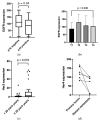Growth Factor Receptor Expression in Oropharyngeal Squamous Cell Cancer: Her1-4 and c-Met in Conjunction with the Clinical Features and Human Papillomavirus (p16) Status
- PMID: 33202816
- PMCID: PMC7697064
- DOI: 10.3390/cancers12113358
Growth Factor Receptor Expression in Oropharyngeal Squamous Cell Cancer: Her1-4 and c-Met in Conjunction with the Clinical Features and Human Papillomavirus (p16) Status
Abstract
This study aimed to assess the distribution of growth factor receptors in oropharyngeal squamous cell cancer (OPSCC) and evaluate their role in the context of human papillomavirus (HPV) status, prognosis and potential relevance for targeted therapy. The protein expression of human epidermal growth factor receptor (Her)1-4 and c-Met were retrospectively assessed using semiquantitative immunohistochemistry on tissue microarrays and analyzed for correlations as well as differences in the clinicopathological criteria. Her1-4 and c-met were overexpressed compared to normal mucosa in 46%, 4%, 17%, 27% and 23%, respectively. Interestingly, most receptors were coexpressed. Her1 and c-Met were inversely correlated with p16 (p = 0.04; p = 0.02). Her2 and c-Met were associated with high tobacco consumption (p = 0.016; p = 0.04). High EGFR, Her3, Her4 and c-Met expression were associated with worse overall and disease-free survival (p ≤ 0.05). Furthermore, EGFR and c-Met expression showed raised hazard ratios of 2.53 (p = 0.02; 95% CI 1.24-5.18) and 2.45 (p = 0.02; 95% CI 1.13-5.35), respectively. Her4 was expressed less in distant metastases than in corresponding primary tumors and was correlated to a higher T category. EGFR and c-Met are relevant negative prognostic factors in OPSCC, independent of known clinicopathological parameters. We suggest dual targeting of EGFR and c-Met as a promising strategy for OPSCC treatment.
Keywords: EGFR; HPV; c-Met; growth factor receptor; immunohistochemistry; oropharyngeal squamous cell cancer OPSCC; p16; targeted therapy.
Conflict of interest statement
The authors declare that the research was conducted in the absence of any commercial or financial relationships that could be construed as a potential conflict of interest.
Figures




Similar articles
-
Molecular subclassification determined by human papillomavirus and epidermal growth factor receptor status is associated with the prognosis of oropharyngeal squamous cell carcinoma.Hum Pathol. 2016 Apr;50:51-61. doi: 10.1016/j.humpath.2015.11.001. Epub 2015 Nov 17. Hum Pathol. 2016. PMID: 26997438
-
A Correlative Analysis of PD-L1, PD-1, PD-L2, EGFR, HER2, and HER3 Expression in Oropharyngeal Squamous Cell Carcinoma.Mol Cancer Ther. 2018 Mar;17(3):710-716. doi: 10.1158/1535-7163.MCT-17-0504. Epub 2018 Feb 13. Mol Cancer Ther. 2018. PMID: 29440293 Free PMC article.
-
The prognostic significance of the biomarker p16 in oropharyngeal squamous cell carcinoma.Clin Oncol (R Coll Radiol). 2013 Nov;25(11):630-8. doi: 10.1016/j.clon.2013.07.003. Epub 2013 Jul 31. Clin Oncol (R Coll Radiol). 2013. PMID: 23916365
-
Growth factor receptor expression in anal squamous lesions: modifications associated with oncogenic human papillomavirus and human immunodeficiency virus.Hum Pathol. 2009 Nov;40(11):1517-27. doi: 10.1016/j.humpath.2009.05.010. Epub 2009 Aug 27. Hum Pathol. 2009. PMID: 19716155
-
Advances in Diagnosis and Multidisciplinary Management of Oropharyngeal Squamous Cell Carcinoma: State of the Art.Radiographics. 2019 Nov-Dec;39(7):2055-2068. doi: 10.1148/rg.2019190007. Epub 2019 Oct 11. Radiographics. 2019. PMID: 31603733 Review.
Cited by
-
Profiling Cisplatin Resistance in Head and Neck Cancer: A Critical Role of the VRAC Ion Channel for Chemoresistance.Cancers (Basel). 2021 Sep 27;13(19):4831. doi: 10.3390/cancers13194831. Cancers (Basel). 2021. PMID: 34638315 Free PMC article.
-
Prognostic stratification of oropharyngeal cancer patients in a betel nut chewing and low HPV area.J Otolaryngol Head Neck Surg. 2023 Apr 20;52(1):27. doi: 10.1186/s40463-023-00632-x. J Otolaryngol Head Neck Surg. 2023. PMID: 37081578 Free PMC article.
-
Impact of Secretion-Active Osteoblast-Specific Factor 2 in Promoting Progression and Metastasis of Head and Neck Cancer.Cancers (Basel). 2022 May 9;14(9):2337. doi: 10.3390/cancers14092337. Cancers (Basel). 2022. PMID: 35565465 Free PMC article.
-
Standardized Digital Image Analysis of PD-L1 Expression in Head and Neck Squamous Cell Carcinoma Reveals Intra- and Inter-Sample Heterogeneity with Therapeutic Implications.Cancers (Basel). 2024 May 31;16(11):2103. doi: 10.3390/cancers16112103. Cancers (Basel). 2024. PMID: 38893222 Free PMC article.
-
IsoMAG-An Automated System for the Immunomagnetic Isolation of Squamous Cell Carcinoma-Derived Circulating Tumor Cells.Diagnostics (Basel). 2021 Nov 4;11(11):2040. doi: 10.3390/diagnostics11112040. Diagnostics (Basel). 2021. PMID: 34829387 Free PMC article.
References
-
- Beltz A., Gosswein D., Zimmer S., Limburg I., Wunsch D., Gribko A., Deichelbohrer M., Hagemann J., Stauber R.H., Kunzel J. Staging of oropharyngeal squamous cell carcinoma of the head and neck: Prognostic features and power of the 8th edition of the UICC staging manual. Eur. J. Surg. Oncol. 2019;45:1046–1053. doi: 10.1016/j.ejso.2019.02.032. - DOI - PubMed
-
- Mahal B.A., Catalano P.J., Haddad R.I., Hanna G.J., Kass J.I., Schoenfeld J.D., Tishler R.B., Margalit D.N. Incidence and demographic burden of HPV-associated oropharyngeal head and neck cancers in the United States. Cancer Epidemiol. Prev. Biomark. 2019;28:1660–1667. doi: 10.1158/1055-9965.EPI-19-0038. - DOI - PubMed
LinkOut - more resources
Full Text Sources
Research Materials
Miscellaneous

